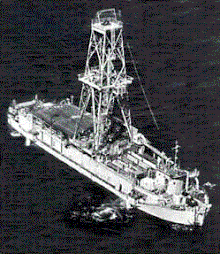Project Mohole
 One of the six submerged buoys used for dynamic positioning in Project Mohole. They were lowered to about 200 feet into a circular pattern. The CUSS I would then use sonar to manoeuvre itself in the centre of that circle. | |
| Date | 1961 |
|---|---|
| Location | Off Guadalupe Island, Mexico, Pacific Ocean |
| Outcome | Failed attempt to enter the Mohorovičić discontinuity |
Project Mohole was an ambitious attempt in the early 1960s to drill through the Earth's crust into the Mohorovičić discontinuity, and to provide an Earth science complement to the high-profile Space Race. The project was initially led by the American Miscellaneous Society with funding from the National Science Foundation.
History

Phase One was executed in spring 1961. Five holes were drilled off the coast of Guadalupe Island, Mexico, the deepest to 601 ft (183 m) below the sea floor in 11,700 ft (3,600 m) of water. This was unprecedented: not in the hole's depth but because of the depth of the ocean and because it was drilled from an untethered platform. Also, the core sample proved to be valuable, penetrating through Miocene-age sediments for the first time to reveal the lowest 13 m (44 ft) consisting of basalt.
Project Mohole contracted with Global Marine of Los Angeles for the use of its oil drillship CUSS I. A consortium of Continental, Union, Superior and Shell Oil Companies, CUSS had originally developed it in 1956 as a technological test bed for the nascent offshore oil industry. CUSS I was one of the first vessels in the world capable of drilling in water depth up to 11,700 ft (3,600 m), while maintaining a position within a radius of 600 ft (180 m). Project Mohole expanded its operational range by inventing what is now known as dynamic positioning.[1]
Phase One proved that both the technology and expertise were available to drill into the Earth's mantle. It was intended as the experimental phase of the project, and did succeed in drilling to a depth of 601 feet below the sea floor.[2][3] However, deeper drilling never took place. An attempted shift of operational control to the National Science Foundation proved unsatisfactory, and in short order the American Miscellaneous Society dissolved itself, Phase Two of the project was abandoned and the entire project was discontinued by Congress, which objected to increasing costs in 1966.[2][3]
See also
References
- ↑ Van Keuren, David K. (2004). "Chapter 6: Breaking New Ground-The Origins of Scientific Ocean Drilling". The Machine in Neptune's Garden: Historical Perspectives on Technology and the Marine Environment. Science History Publications. pp. 183–210. ISBN 0881353728. Retrieved 1 March 2014.
- 1 2 Project Mohole, 1958-1966, National Academies, retrieved 2011-04-22
- 1 2 "Project Mohole". IODP. Archived from the original on 6 March 2014. Retrieved 5 March 2014.
Bibliography
- A Hole in the Bottom of the Sea: The Story of the Mohole Project by Willard Bascom, 1961. ISBN 0-385-00711-6
- Oral History Interview. Willard Bascom, 1993.
- Oral History Interview. Robert Bauer, 1993
- Milton Lomask, "A Minor Miracle: An Informal History of the National Science Foundation." NSF
- Chandler, G. N. "Experimental Deep Water Drilling- Project Mohole" (Motion Picture, Library of Congress Catalogue Number: fi 68000006, 28 min)